2016 NISSAN FRONTIER flat tire
[x] Cancel search: flat tirePage 418 of 469
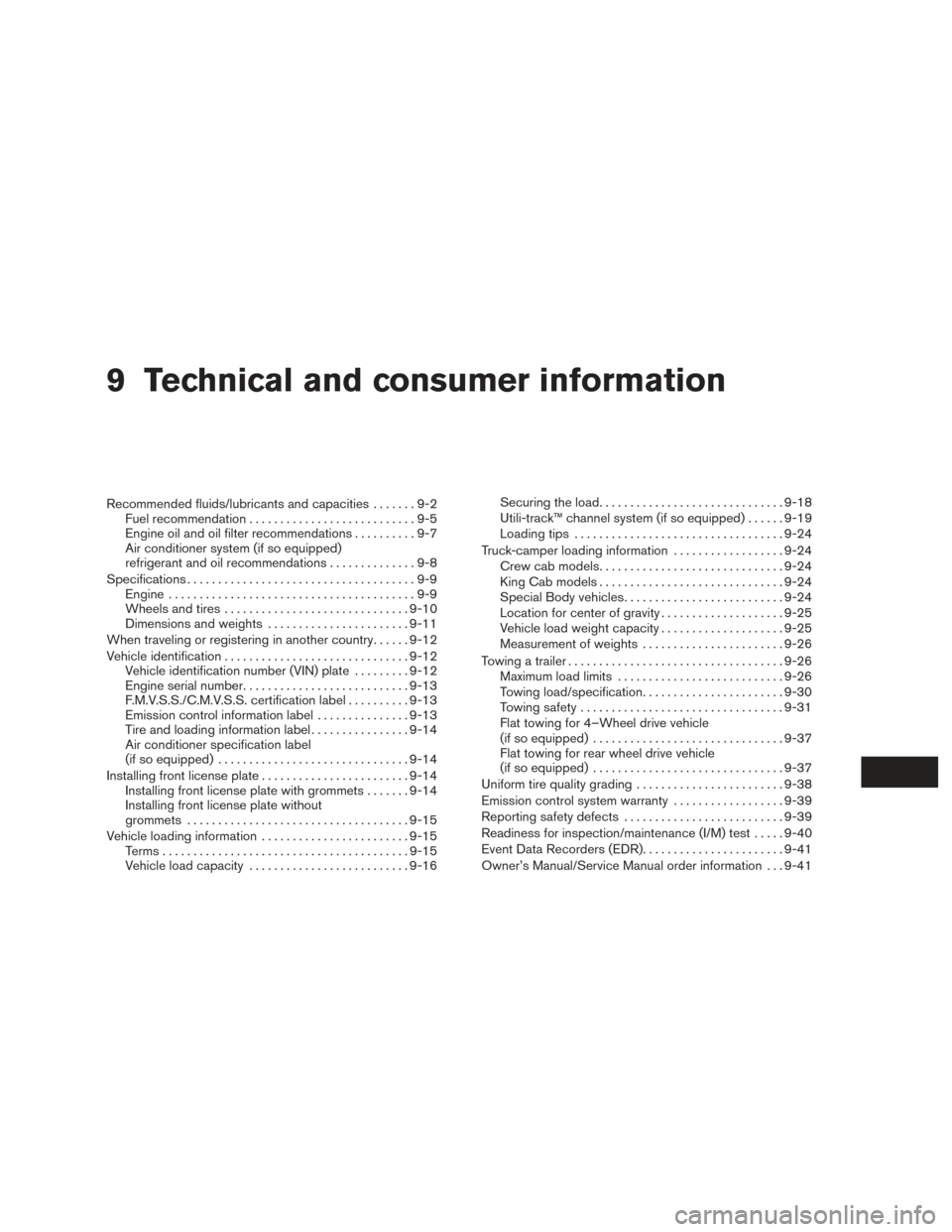
9 Technical and consumer information
Recommended fluids/lubricants and capacities.......9-2
Fuel recommendation ...........................9-5
Engine oil and oil filter recommendations ..........9-7
Air conditioner system (if so equipped)
refrigerant and oil recommendations ..............9-8
Specifications .....................................9-9
Engine ........................................9-9
Wheels and tires .............................. 9-10
Dimensions and weights .......................9-11
When traveling or registering in another country ......9-12
Vehicle identification .............................. 9-12
Vehicle identification number (VIN) plate .........9-12
Engine serial number ........................... 9-13
F.M.V.S.S./C.M.V.S.S. certification label ..........9-13
Emission control information label ...............9-13
Tire and loading information label ................9-14
Air conditioner specification label
(if so equipped) ............................... 9-14
Installing front license plate ........................9-14
Installing front license plate with grommets .......9-14
Installing front license plate without
grommets .................................... 9-15
Vehicle loading information ........................9-15
Terms ........................................ 9-15
Vehicle load capacity .......................... 9-16Securing the load
.............................. 9-18
Utili-track™ channel system (if so equipped) ......9-19
Loading tips .................................. 9-24
Truck-camper loading information ..................9-24
Crew cab models .............................. 9-24
King Cab models .............................. 9-24
Special Body vehicles .......................... 9-24
Location for center of gravity ....................9-25
Vehicle load weight capacity ....................9-25
Measurement of weights .......................9-26
Towing a trailer ................................... 9-26
Maximum load limits ........................... 9-26
Towing load/specification .......................9-30
Towing safety ................................. 9-31
Flat towing
for 4–Wheel drive vehicle
(if so equipped) ............................... 9-37
Flat towing for rear wheel drive vehicle
(if so equipped) ............................... 9-37
Uniform tire quality grading ........................9-38
Emission control system warranty ..................9-39
Reporting safety defects .......................... 9-39
Readiness for inspection/maintenance (I/M) test .....9-40
Event Data Recorders (EDR) .......................9-41
Owner’s Manual/Service Manual order information . . . 9-41
Page 435 of 469
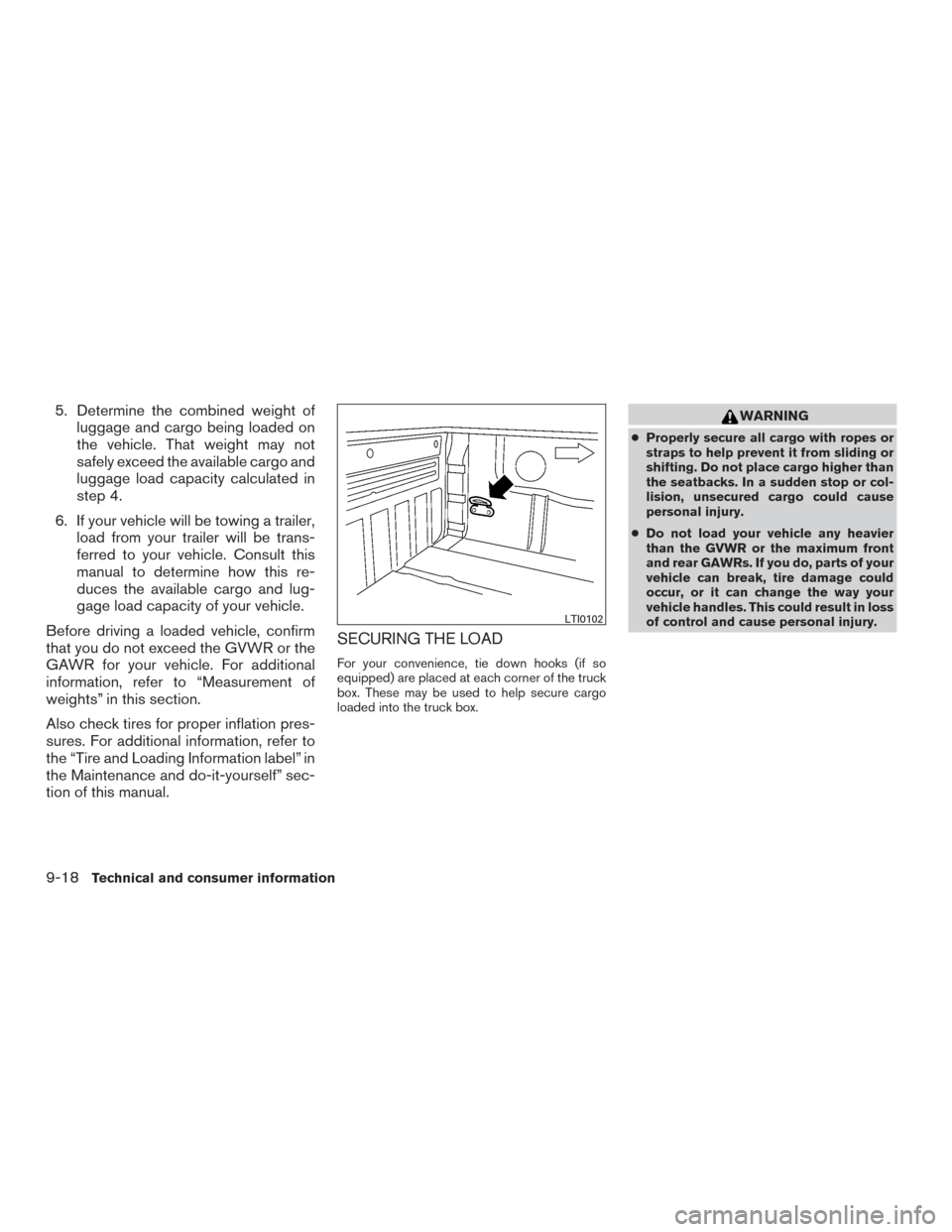
5. Determine the combined weight ofluggage and cargo being loaded on
the vehicle. That weight may not
safely exceed the available cargo and
luggage load capacity calculated in
step 4.
6. If your vehicle will be towing a trailer, load from your trailer will be trans-
ferred to your vehicle. Consult this
manual to determine how this re-
duces the available cargo and lug-
gage load capacity of your vehicle.
Before driving a loaded vehicle, confirm
that you do not exceed the GVWR or the
GAWR for your vehicle. For additional
information, refer to “Measurement of
weights” in this section.
Also check tires for proper inflation pres-
sures. For additional information, refer to
the “Tire and Loading Information label” in
the Maintenance and do-it-yourself” sec-
tion of this manual.
SECURING THE LOAD
For your convenience, tie down hooks (if so
equipped) are placed at each corner of the truck
box. These may be used to help secure cargo
loaded into the truck box.
WARNING
● Properly secure all cargo with ropes or
straps to help prevent it from sliding or
shifting. Do not place cargo higher than
the seatbacks. In a sudden stop or col-
lision, unsecured cargo could cause
personal injury.
● Do not load your vehicle any heavier
than the GVWR or the maximum front
and rear GAWRs. If you do, parts of your
vehicle can break, tire damage could
occur, or it can change the way your
vehicle handles. This could result in loss
of control and cause personal injury.
LTI0102
9-18Technical and consumer information
Page 442 of 469
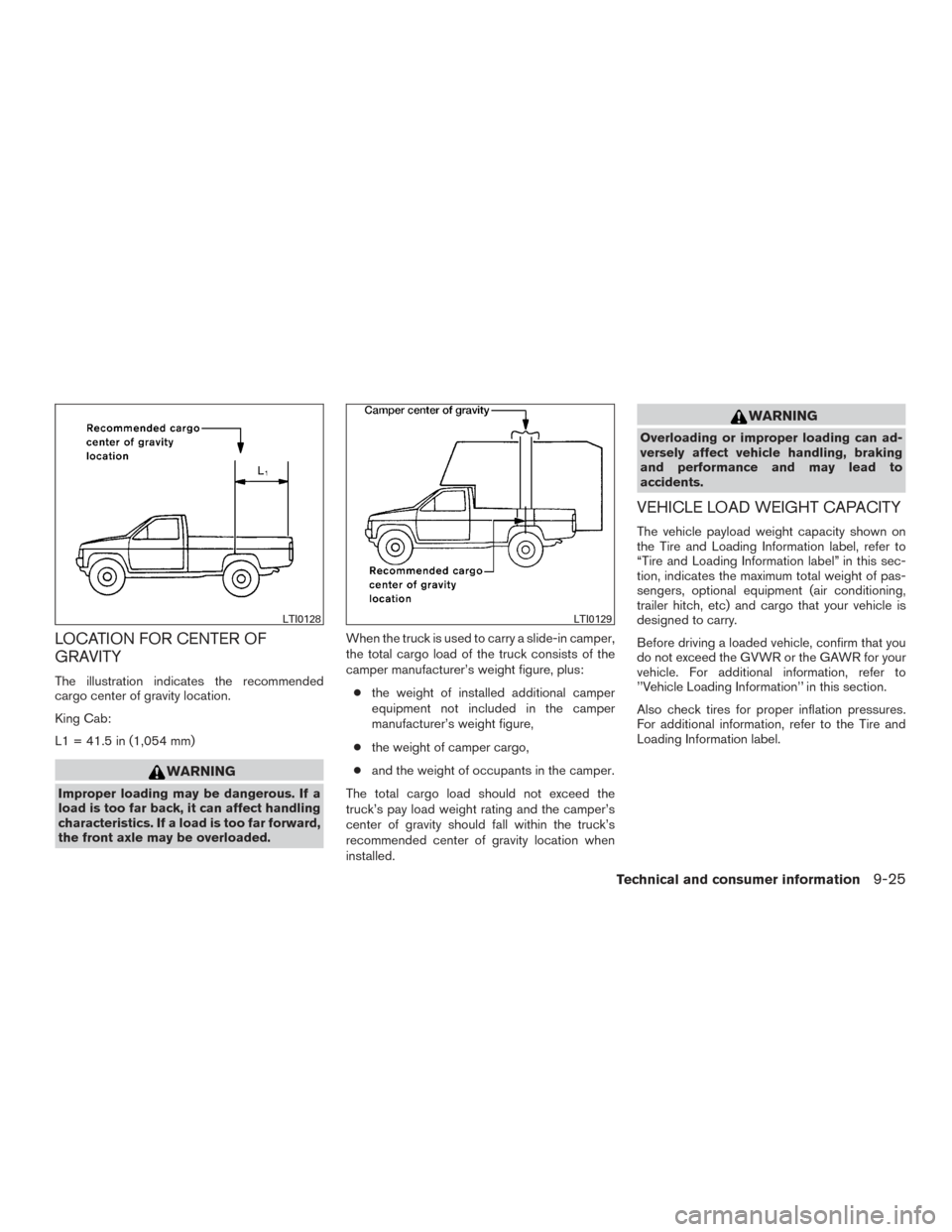
LOCATION FOR CENTER OF
GRAVITY
The illustration indicates the recommended
cargo center of gravity location.
King Cab:
L1 = 41.5 in (1,054 mm)
WARNING
Improper loading may be dangerous. If a
load is too far back, it can affect handling
characteristics. If a load is too far forward,
the front axle may be overloaded.When the truck is used to carry a slide-in camper,
the total cargo load of the truck consists of the
camper manufacturer’s weight figure, plus:
● the weight of installed additional camper
equipment not included in the camper
manufacturer’s weight figure,
● the weight of camper cargo,
● and the weight of occupants in the camper.
The total cargo load should not exceed the
truck’s pay load weight rating and the camper’s
center of gravity should fall within the truck’s
recommended center of gravity location when
installed.
WARNING
Overloading or improper loading can ad-
versely affect vehicle handling, braking
and performance and may lead to
accidents.
VEHICLE LOAD WEIGHT CAPACITY
The vehicle payload weight capacity shown on
the Tire and Loading Information label, refer to
“Tire and Loading Information label” in this sec-
tion, indicates the maximum total weight of pas-
sengers, optional equipment (air conditioning,
trailer hitch, etc) and cargo that your vehicle is
designed to carry.
Before driving a loaded vehicle, confirm that you
do not exceed the GVWR or the GAWR for your
vehicle. For additional information, refer to
’’Vehicle Loading Information’’ in this section.
Also check tires for proper inflation pressures.
For additional information, refer to the Tire and
Loading Information label.
LTI0128LTI0129
Technical and consumer information9-25
Page 450 of 469
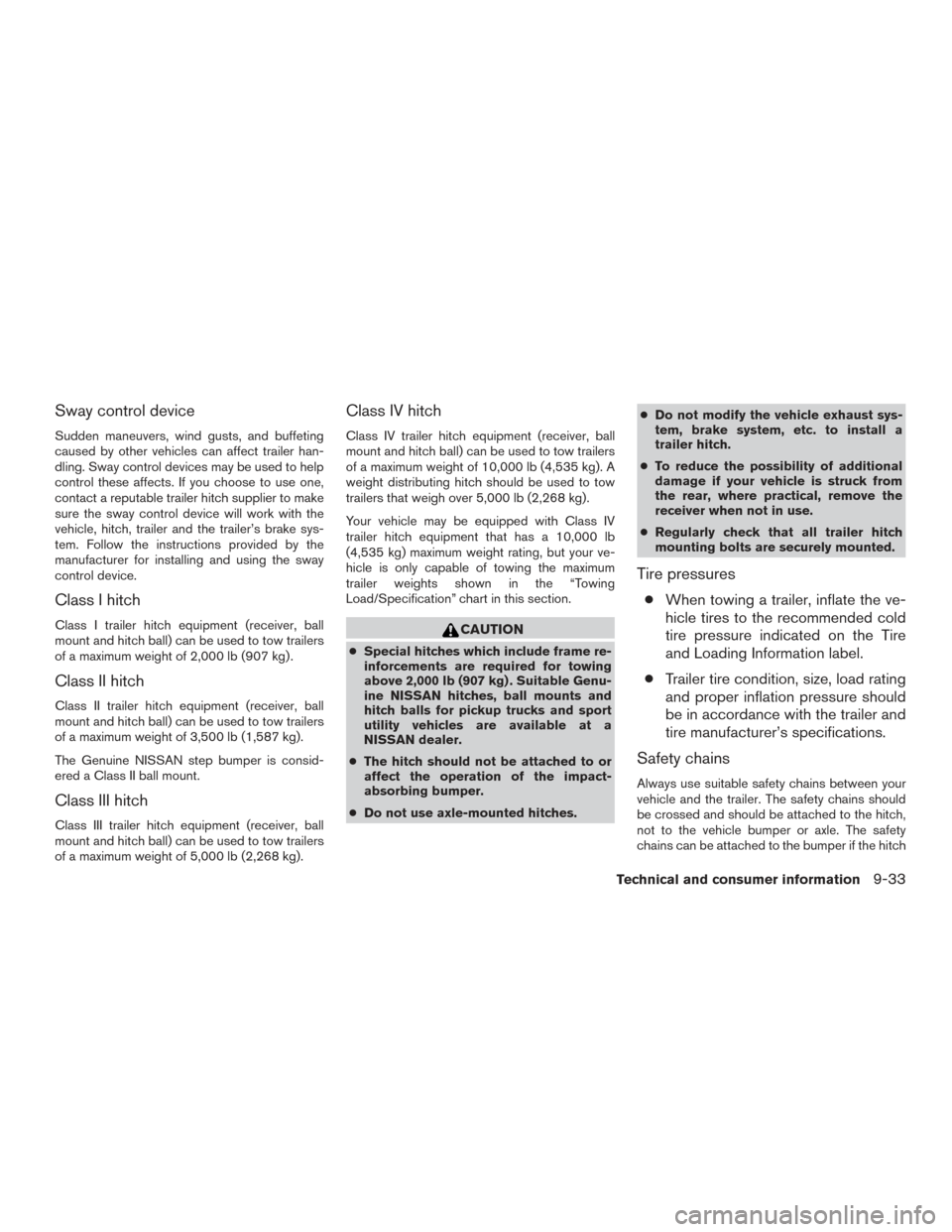
Sway control device
Sudden maneuvers, wind gusts, and buffeting
caused by other vehicles can affect trailer han-
dling. Sway control devices may be used to help
control these affects. If you choose to use one,
contact a reputable trailer hitch supplier to make
sure the sway control device will work with the
vehicle, hitch, trailer and the trailer’s brake sys-
tem. Follow the instructions provided by the
manufacturer for installing and using the sway
control device.
Class I hitch
Class I trailer hitch equipment (receiver, ball
mount and hitch ball) can be used to tow trailers
of a maximum weight of 2,000 lb (907 kg) .
Class II hitch
Class II trailer hitch equipment (receiver, ball
mount and hitch ball) can be used to tow trailers
of a maximum weight of 3,500 lb (1,587 kg).
The Genuine NISSAN step bumper is consid-
ered a Class II ball mount.
Class III hitch
Class III trailer hitch equipment (receiver, ball
mount and hitch ball) can be used to tow trailers
of a maximum weight of 5,000 lb (2,268 kg).
Class IV hitch
Class IV trailer hitch equipment (receiver, ball
mount and hitch ball) can be used to tow trailers
of a maximum weight of 10,000 lb (4,535 kg). A
weight distributing hitch should be used to tow
trailers that weigh over 5,000 lb (2,268 kg).
Your vehicle may be equipped with Class IV
trailer hitch equipment that has a 10,000 lb
(4,535 kg) maximum weight rating, but your ve-
hicle is only capable of towing the maximum
trailer weights shown in the “Towing
Load/Specification” chart in this section.
CAUTION
●Special hitches which include frame re-
inforcements are required for towing
above 2,000 lb (907 kg) . Suitable Genu-
ine NISSAN hitches, ball mounts and
hitch balls for pickup trucks and sport
utility vehicles are available at a
NISSAN dealer.
● The hitch should not be attached to or
affect the operation of the impact-
absorbing bumper.
● Do not use axle-mounted hitches. ●
Do not modify the vehicle exhaust sys-
tem, brake system, etc. to install a
trailer hitch.
● To reduce the possibility of additional
damage if your vehicle is struck from
the rear, where practical, remove the
receiver when not in use.
● Regularly check that all trailer hitch
mounting bolts are securely mounted.
Tire pressures
● When towing a trailer, inflate the ve-
hicle tires to the recommended cold
tire pressure indicated on the Tire
and Loading Information label.
● Trailer tire condition, size, load rating
and proper inflation pressure should
be in accordance with the trailer and
tire manufacturer’s specifications.
Safety chains
Always use suitable safety chains between your
vehicle and the trailer. The safety chains should
be crossed and should be attached to the hitch,
not to the vehicle bumper or axle. The safety
chains can be attached to the bumper if the hitch
Technical and consumer information9-33
Page 454 of 469
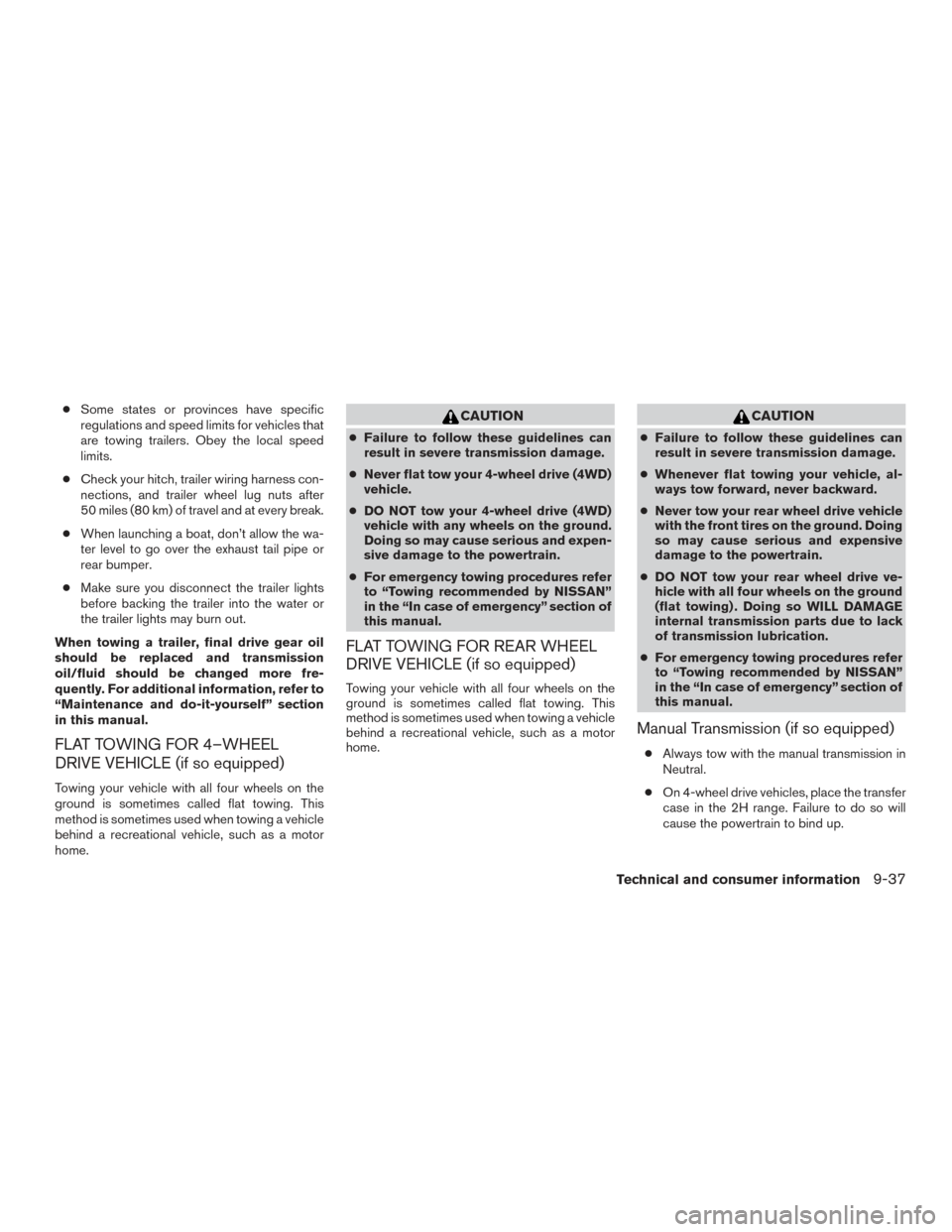
●Some states or provinces have specific
regulations and speed limits for vehicles that
are towing trailers. Obey the local speed
limits.
● Check your hitch, trailer wiring harness con-
nections, and trailer wheel lug nuts after
50 miles (80 km) of travel and at every break.
● When launching a boat, don’t allow the wa-
ter level to go over the exhaust tail pipe or
rear bumper.
● Make sure you disconnect the trailer lights
before backing the trailer into the water or
the trailer lights may burn out.
When towing a trailer, final drive gear oil
should be replaced and transmission
oil/fluid should be changed more fre-
quently. For additional information, refer to
“Maintenance and do-it-yourself” section
in this manual.
FLAT TOWING FOR 4–WHEEL
DRIVE VEHICLE (if so equipped)
Towing your vehicle with all four wheels on the
ground is sometimes called flat towing. This
method is sometimes used when towing a vehicle
behind a recreational vehicle, such as a motor
home.
CAUTION
● Failure to follow these guidelines can
result in severe transmission damage.
● Never flat tow your 4-wheel drive (4WD)
vehicle.
● DO NOT tow your 4-wheel drive (4WD)
vehicle with any wheels on the ground.
Doing so may cause serious and expen-
sive damage to the powertrain.
● For emergency towing procedures refer
to “Towing recommended by NISSAN”
in the “In case of emergency” section of
this manual.
FLAT TOWING FOR REAR WHEEL
DRIVE VEHICLE (if so equipped)
Towing your vehicle with all four wheels on the
ground is sometimes called flat towing. This
method is sometimes used when towing a vehicle
behind a recreational vehicle, such as a motor
home.
CAUTION
●Failure to follow these guidelines can
result in severe transmission damage.
● Whenever flat towing your vehicle, al-
ways tow forward, never backward.
● Never tow your rear wheel drive vehicle
with the front tires on the ground. Doing
so may cause serious and expensive
damage to the powertrain.
● DO NOT tow your rear wheel drive ve-
hicle with all four wheels on the ground
(flat towing) . Doing so WILL DAMAGE
internal transmission parts due to lack
of transmission lubrication.
● For emergency towing procedures refer
to “Towing recommended by NISSAN”
in the “In case of emergency” section of
this manual.
Manual Transmission (if so equipped)
● Always tow with the manual transmission in
Neutral.
● On 4-wheel drive vehicles, place the transfer
case in the 2H range. Failure to do so will
cause the powertrain to bind up.
Technical and consumer information9-37
Page 455 of 469
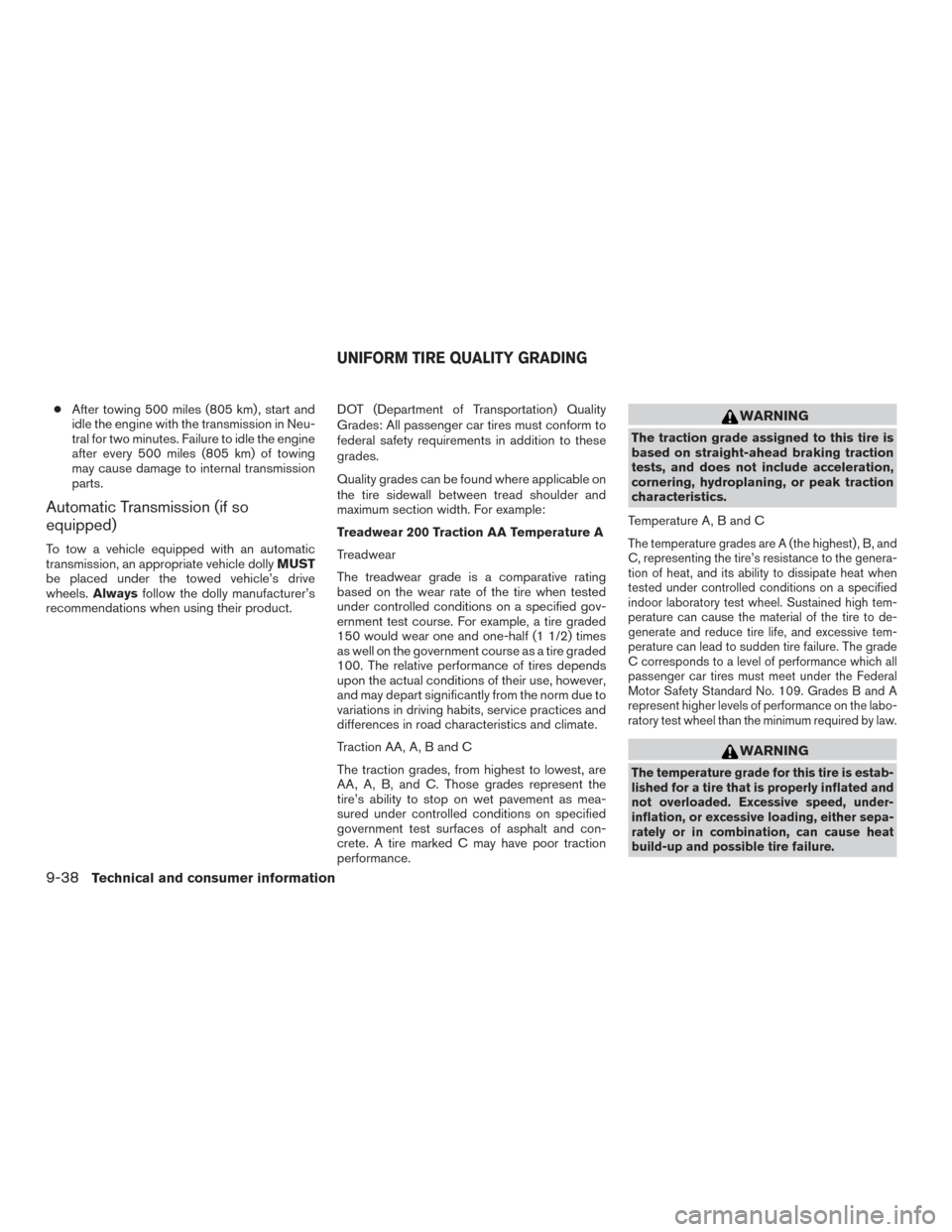
●After towing 500 miles (805 km) , start and
idle the engine with the transmission in Neu-
tral for two minutes. Failure to idle the engine
after every 500 miles (805 km) of towing
may cause damage to internal transmission
parts.
Automatic Transmission (if so
equipped)
To tow a vehicle equipped with an automatic
transmission, an appropriate vehicle dolly MUST
be placed under the towed vehicle’s drive
wheels. Always follow the dolly manufacturer’s
recommendations when using their product. DOT (Department of Transportation) Quality
Grades: All passenger car tires must conform to
federal safety requirements in addition to these
grades.
Quality grades can be found where applicable on
the tire sidewall between tread shoulder and
maximum section width. For example:
Treadwear 200 Traction AA Temperature A
Treadwear
The treadwear grade is a comparative rating
based on the wear rate of the tire when tested
under controlled conditions on a specified gov-
ernment test course. For example, a tire graded
150 would wear one and one-half (1 1/2) times
as well on the government course as a tire graded
100. The relative performance of tires depends
upon the actual conditions of their use, however,
and may depart significantly from the norm due to
variations in driving habits, service practices and
differences in road characteristics and climate.
Traction AA, A, B and C
The traction grades, from highest to lowest, are
AA, A, B, and C. Those grades represent the
tire’s ability to stop on wet pavement as mea-
sured under controlled conditions on specified
government test surfaces of asphalt and con-
crete. A tire marked C may have poor traction
performance.
WARNING
The traction grade assigned to this tire is
based on straight-ahead braking traction
tests, and does not include acceleration,
cornering, hydroplaning, or peak traction
characteristics.
Temperature A, B and C
The temperature grades are A (the highest) , B, and
C, representing the tire’s resistance to the genera-
tion of heat, and its ability to dissipate heat when
tested under controlled conditions on a specified
indoor laboratory test wheel. Sustained high tem-
perature can cause the material of the tire to de-
generate and reduce tire life, and excessive tem-
perature can lead to sudden tire failure. The grade
C corresponds to a level of performance which all
passenger car tires must meet under the Federal
Motor Safety Standard No. 109. Grades B and A
represent higher levels of performance on the labo-
ratory test wheel than the minimum required by law.
WARNING
The temperature grade for this tire is estab-
lished for a tire that is properly inflated and
not overloaded. Excessive speed, under-
inflation, or excessive loading, either sepa-
rately or in combination, can cause heat
build-up and possible tire failure.
UNIFORM TIRE QUALITY GRADING
9-38Technical and consumer information
Page 462 of 469
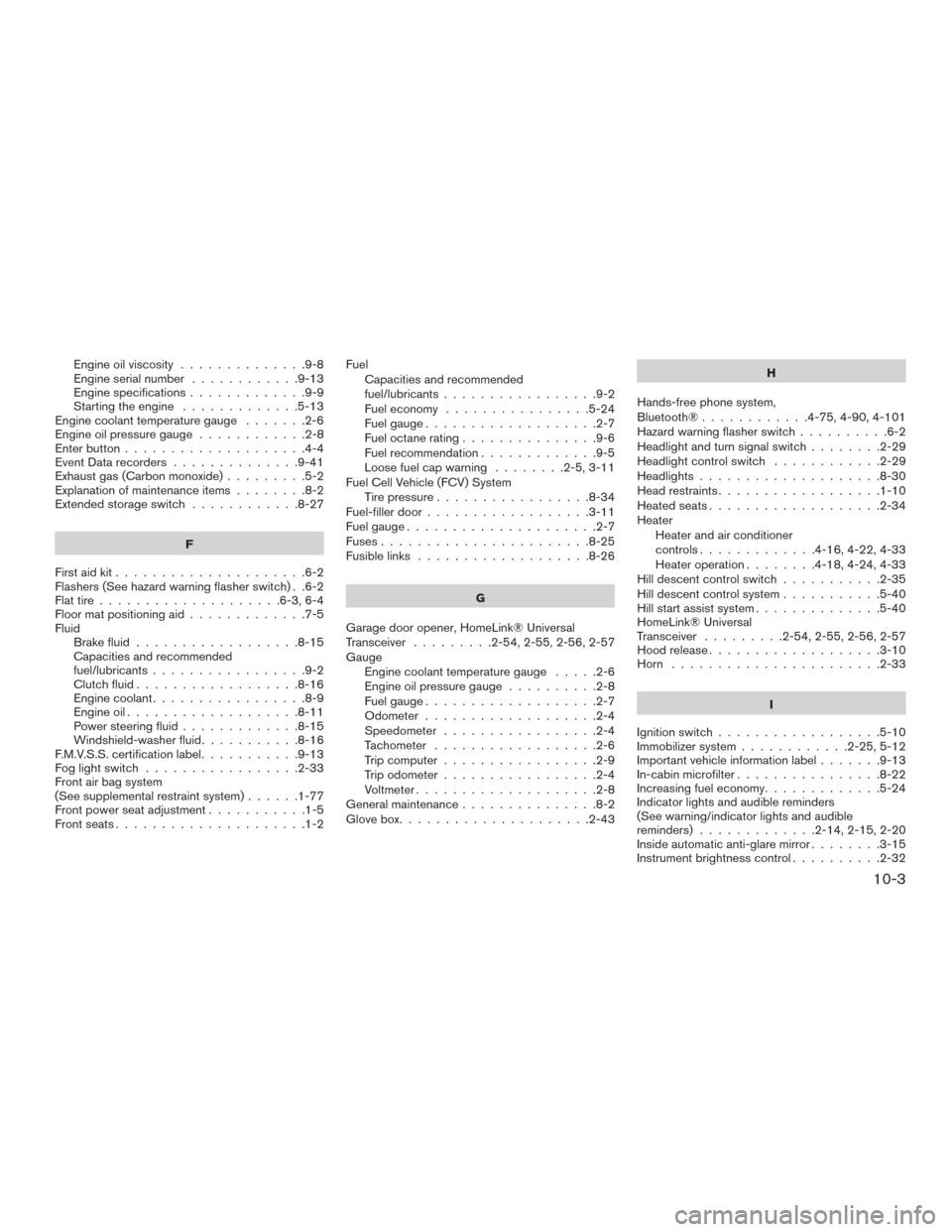
Engine oil viscosity..............9-8
Engine serial number ............9-13
Engine specifications .............9-9
Starting the engine .............5-13
Engine coolant temperature gauge .......2-6
Engineoilpressuregauge............2-8
Enterbutton....................4-4
Event Data recorders ..............9-41
Exhaust gas (Carbon monoxide) .........5-2
Explanation of maintenance items ........8-2
Extendedstorageswitch ............8-27
F
First aid kit .....................6-2
Flashers (See hazard warning flasher switch) . .6-2
Flat tire ....................6-3,6-4
Floor mat positioning aid .............7-5
Fluid Brake fluid ..................8-15
Capacities and recommended
fuel/lubricants .................9-2
Clutchfluid..................8-16
Engine coolant .................8-9
Engine oil ...................8-11
Power steering fluid .............8-15
Windshield-washerfluid...........8-16
F.M.V.S.S. certification label ...........9-13
Foglightswitch .................2-33
Front air bag system
(See supplemental restraint system) ......1-77
Front power seat adjustment ...........1-5
Frontseats.....................1-2 Fuel
Capacities and recommended
fuel/lubricants .................9-2
Fuel economy ................5-24
Fuel gauge ...................2-7
Fuel octane rating ...............9-6
Fuel recommendation .............9-5
Loose fuel cap warning ........2-5,3-11
Fuel Cell Vehicle (FCV) System Tirepressure.................8-34
Fuel-filler door ..................3-11
Fuelgauge.....................2-7
Fuses.......................8-25
Fusiblelinks ...................8-26
G
Garage door opener, HomeLink® Universal
Transceiver .........2-54,2-55,2-56,2-57
Gauge Engine coolant temperature gauge .....2-6
Engine oil pressure gauge ..........2-8
Fuel gauge ...................2-7
Odometer ...................2-4
Speedometer .................2-4
Tachometer ..................2-6
Trip computer .................2-9
Trip odometer .................2-4
Voltmeter....................2-8
General maintenance ...............8-2
Glovebox.....................2-43 H
Hands-free phone system,
Bluetooth®............4-75,4-90,4-101
Hazard warning flasher switch ..........6-2
Headlightandturnsignalswitch........2-29
Headlightcontrolswitch ............2-29
Headlights....................8-30
Head restraints ..................1-10
Heated seats ...................2-34
Heater Heater and air conditioner
controls .............4-16,4-22,4-33
Heater operation ........4-18,4-24,4-33
Hill descent control switch ...........2-35
Hill descent control system ...........
5
-40
Hill start assist system ..............5-40
HomeLink® Universal
Transceiver .........2-54,2-55,2-56,2-57
Hoodrelease...................3-10
Horn .......................2-33
I
Ignition switch ..................5-10
Immobilizer system ............2-25,5-12
Important vehicle information label .......9-13
In-cabin microfilter ................8-22
Increasing fuel economy .............5-24
Indicator lights and audible reminders
(See warning/indicator lights and audible
reminders).............2-14,2-15,2-20
Inside automatic anti-glare mirror ........3-15
Instrument brightness control ..........2-32
10-3
Page 465 of 469
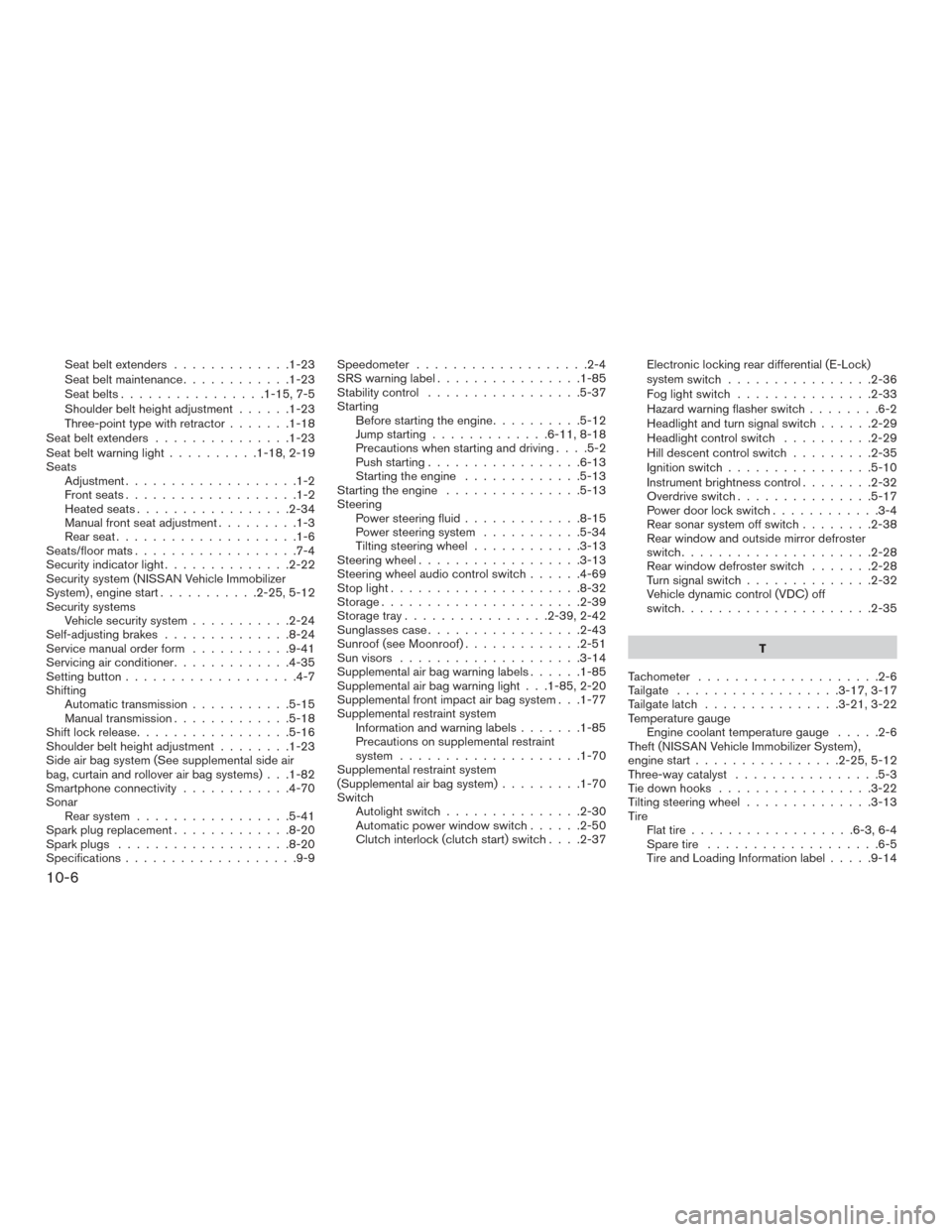
Seat belt extenders.............1-23
Seat belt maintenance ............1-23
Seat belts ................1-15,7-5
Shoulder belt height adjustment ......1-23
Three-point type with retractor .......1-18
Seat belt extenders ...............1-23
Seatbeltwarninglight..........1-18,2-19
Seats Adjustment ...................1-2
Frontseats...................1-2
Heatedseats.................2-34
Manual front seat adjustment .........1-3
Rear seat ....................1-6
Seats/floor mats ..................7-4
Security indicator light ..............2-22
Security system (NISSAN Vehicle Immobilizer
System) , engine start ...........2-25,5-12
Security systems Vehicle security system ...........2-24
Self-adjusting brakes ..............8-24
Service manual order form ...........9-41
Servicing air conditioner .............4-35
Setting button ...................4-7
Shifting Automatic transmission ...........5-15
Manual transmission .............5-18
Shift lock release .................5-16
Shoulder belt height adjustment ........1-23
Side air bag system (See supplemental side air
bag, curtain and rollover air bag systems) . . .1-82
Smartphone connectivity ............4-70
Sonar Rear system .................5-41
Spark plug replacement .............8-20
Spark plugs ...................8-20
Specifications ...................9-9 Speedometer
...................2-4
SRSwarninglabel................1-85
Stability control .................5-37
Starting Before starting the engine ..........5-12
Jump starting .............6-11,8-18
Precautions when starting and driving ....5-2
Push starting .................6-13
Starting the engine .............5-13
Starting the engine ...............5-13
Steering Power steering fluid .............8-15
Power steering system ...........5-34
Tilting steering wheel ............3-13
Steeringwheel..................3-13
Steering wheel audio control switch ......4-69
Stoplight.....................8-32
Storage......................2-39
Storage tray ................2-39,2-42
Sunglassescase.................2-43
Sunroof(seeMoonroof).............2-51
Sun visors ....................3-14
Supplemental air bag warning labels ......1-85
Supplemental air bag warning light . . .1-85, 2-20
Supplemental front impact air bag system . . .1-77
Supplemental restraint system Information and warning labels .......1-85
Precautions on supplemental restraint
system ....................1-70
Supplemental restraint system
(Supplemental air bag system) .........1-70
Switch Autolightswitch...............2-30
Automatic power window switch ......2-50
Clutch interlock (clutch start) switch ....2-37Electronic locking rear differential (E-Lock)
system
switch ................
2-36
Fog light switch ...............2-33
Hazard warning flasher switch ........6-2
Headlightandturnsignalswitch......2-29
Headlight control switch ..........2-29
Hilldescentcontrolswitch.........2-35
Ignition switch ................5-10
Instrument brightness control ........2-32
Overdrive switch ...............5-17
Power door lock switch ............3-4
Rear sonar system off switch ........2-38
Rear window and outside mirror defroster
switch .....................2-28
Rearwindowdefrosterswitch .......2-28
Turnsignalswitch..............2-32
Vehicle dynamic control (VDC) off
switch .....................2-35
T
Tachometer ....................2-6
Tailgate ..................3-17,3-17
Tailgate latch ...............3-21,3-22
Temperature gauge Engine coolant temperature gauge .....2-6
Theft (NISSAN Vehicle Immobilizer System) ,
engine start ................2-25,5-12
Three-way catalyst ................5-3
Tie down hooks .................3-22
Tilting steering wheel ..............3-13
Tire Flat tire ..................6-3,6-4
Spare tire ...................6-5
Tire and Loading Information label .....9-14
10-6